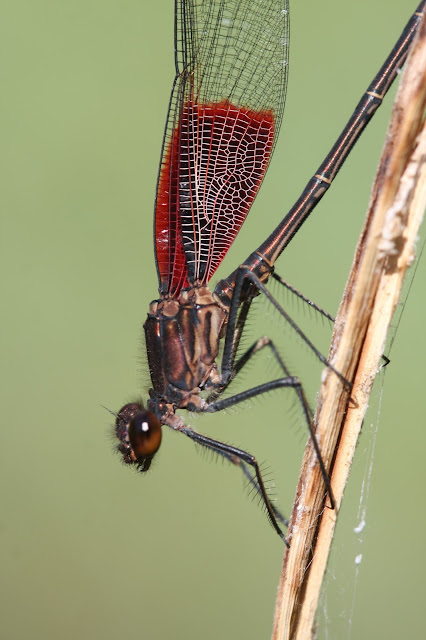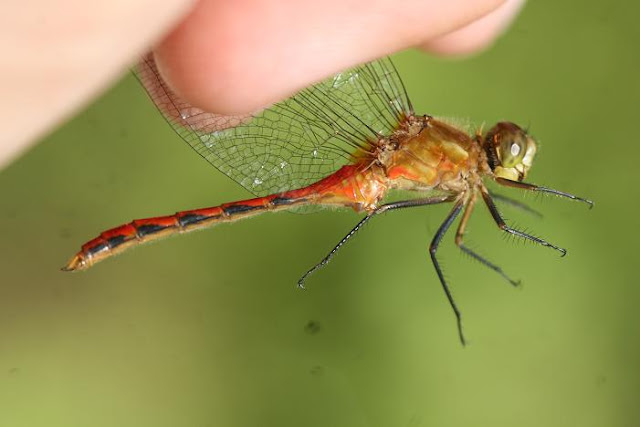I've had the pleasure of teaching many groups children from preschool to high school age during the last decade or so in a variety of settings: camps, classrooms, field trips and informal natural history discoveries on the sidewalk (just recently jumping galls in the Central Valley here).
One activity that I have done a few times, and particularly enjoyed, was doing a mark and recapture study on dragonflies with elementary/middle school students. In my opinion, it is a pretty perfect project - you get to teach the scientific method, a little bit of math, and a good bit of natural history. I didn't come up with this project (I think Taylor Yeager, of Mass Audubon, suggested doing it with grasshoppers, initially - but that was the summer of 2006 or 2007, so my memory is a bit hazy) but I've run it a few times with kids from ~9 years old to high school age.
 |
| Hetaerina americana, the American rubyspot, my favorite odonate in California. A damselfly, these are just as suitable for the study described here, though a little more fragile. |
The goal of the project is simply to estimate the number of dragonflies in a given area such as a large field or a pond. You could easily adapt this to grasshoppers, milkweed beetles or any other larger invertebrate that can be easily handled and marked (bumblebees or butterflies might not be as good). Mark and recapture is a standard technique used in wildlife studies and the basic idea of it is very simple - you mark a known number of animals, then you go back and capture a bunch and see what proportion of that sample was marked. Obviously, in real-world applications,
the math is much more complicated, but for our purposes, if we mark ten bugs the first day and capture 10 the second day, two of which are marked, we have a population size of 50.
 |
| You'll almost certainly see Pantala flavescens, the world's most widespread dragonfly. Catching them is a bit harder - they fly high and fast! This is a female. |
Dragonflies are supremely suited to this activity however. They are often abundant, easy to handle and mark, children generally have no aversion to them and they are just challenging enough to catch to occupy students for hours (and to get lots of energy out while running around the field with nets!).
 |
| Rhionaeschna sp. Chiloe Island, Chile. WHO DOESN'T LOVE DRAGONFLIES?!? |
Of course, the first thing you should do is to get all the students to guess the number of dragonflies in that area. They generally have no idea; guesses vary by orders of magnitude (from 10 to 1 million!). Then it is just a matter of giving everyone nets, teaching them to safely handle dragonflies and going out and catching 'em. We've used normal sharpies and put a dark band on both forewings of the individuals we captured as a mark. For easier record-keeping, we set up a station in the center with the sharpies. I found with younger students, it was easier (and safer for the insect) if I took it out of the net and marked it (those being the two steps where wings are easily shredded or broken), then let the students identify and measure it. Taking dragonflies out of nets isn't hard - put your pointer and middle fingers on opposite sides of their body and gently move their wings up so that you have all four together and remove from net. Even 12 year-olds can remove and mark with proper instruction. Most dragons will need a few seconds to pump haemolymph back into their wings after this process; you can place the
dragonfly on the catcher's nose - this is especially entertaining for all others involved!
 |
| An Aeshna/Rhionaeschna sp. This is the proper way to hold dragonflies; using two fingers, pinch the four wings together gently. To mark it with sharpie, it helps to put the wings flat on a clipboard and gently put a small mark. This is a female - note the lack of a bulge on the bottom of the first couple abdominal segements (compare to photos below). |
 |
| The other way to hold dragonflies is to firmly grip the upper segments of their legs (I usually try to hold two - though I am holding only one in this photo) between thumb and forefinger. This allows viewing of the wing pattern and veination, but is trickier and requires some practice to not rip off legs and let the dragonfly get away. They can also bite you in this grip, not a problem for little ones, but big Aeshnids can draw blood! |
With high school groups, I've taught them how to sex the dragonflies and then made comparisons of male and female sizes and sex ratios. This is an interesting activity, as in upland areas, most caught are females and near water bodies, most are males (you can count on this result with all but a few uncommon species). The reason is that males of most species patrol territories near prime egg-laying spots and catch the females and mate with them immediately prior to egg laying. Females, being harassed constantly near water, generally forage in areas farther away. This is especially pronounced in
Enallagma damselflies - the bright blue males may be found by the hundreds at any pond, but its really hard to find the duller females nearby - sex rations on a local scale may be 100:1 or more!
 |
| Blue dasher, Pachydiplax longipennis, one of the most abundant dragonflies in the US. Note the water mites on its abdomen - these have really interesting natural histories (too long to describe here, but look them up). Also, note the bulge on the lower side of the first couple abdominal segments - this is a male (compare above). |
The next day, we go back out and catch them again - to avoid double counting individuals, we use a second color sharpie on these. Then we conclude by doing the calculation of total population size, figuring out who was closest (the most exciting part for the students) and discussing the drawbacks. The students have always come up with good hypotheses for why the estimate might not be accurate (there were too many high-flying dragonflies, one day was cloudy, etc.) and it generally provides good fodder for a short and informative discussion. With older students, summary statistics on sex ratio, the body size measurements and population sizes of each species can be done and discussed.
 |
| The only individuals we don't mark are tenerals - these are just emerged and they have not fully dried their wings and marking would almost certainly hurt them). Note the glistening wings and really pale body. In another day or two, this Sympetrum sp. will be cherry red! |
 |
| No dragonfly post would be complete without this monster. Arguably the world's largest dragonfly, Phenes raptor lives in bogs in Patagonian Chile and Argentina and has somewhat terrestrial nymphs, an oddity for an odonate. Males also have the coolest set of abdominal claspers (those projections at the tip of the abdomen) of any of the hundreds of species I've seen! |
 |
| The eyes of emeralds, family Corduliidae, lend them that common name. |
What you'll need (not very much!):
1) Nets - 1 per student is ideal, but partners are fine, too. Wooden-handled aerial nets are not expensive (<$10) and will last a long time and take a good bit of abuse.
2) Sharpies
3) A good field guide. I use Dennis Paulson's excellent guides for the US, though there are really good regional ones, like Blair Nikula's Massachusetts guides and others. Identifying dragonflies and damselflies in all but a few genera (
Sympetrum, Enallagma) is really simple and can be done by most high school age children with pretty good accuracy.
4) Clipboard, data sheets.
5) Two days of predicted sunny weather!
 |
| You could have students make nets. During a trip to Peru, my net was stolen within a week. I bought some mosquito netting, bailing wire and made this net for <$1. It lasted me the whole season without issue - several of the dragonflies on this page were caught with it. |
Do give this a try next year if you have students for a couple days! Let me know if you do, I'd love to hear how it goes.
 |
| Another interesting thing to note - and could be measured by the students - is the size of the wings (length, width). This dragonfly, Pantala flavescens, has HUGE wings for its size. Unsurprisingly this species is probably the most migratory and best dispersing insect - of any group - on earth. You can find this species near you - pretty much nomatter where you live! |
 |
| A meadowhawk (Sympetrum sp.) like above. This is a male - told by the bulge in the abdominal segments as well as its red color (females of this genus are yellowish). |







